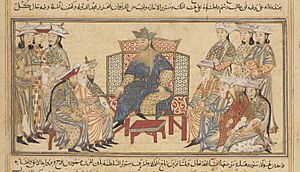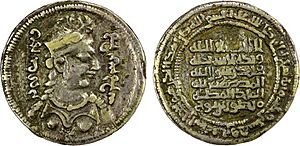Mansur I facts for kids
Quick facts for kids Mansur Iمنصور |
|
|---|---|
| Amir Shahanshah |
|

14th-century illustration of the coronation of Mansur I
|
|
| Amir of the Samanids | |
| Reign | 24 November 961 – 13 June 976 |
| Predecessor | Abd al-Malik I |
| Successor | Nuh II |
| Died | 13 June 976 |
| Issue | Nuh II |
| House | Samanid |
| Father | Nuh I |
| Religion | Sunni Islam |
Mansur I (who was also known as Abu Salih Mansur) was a powerful ruler called an amir. He led the Samanids, a dynasty that ruled a large area in Central Asia and parts of Persia, from 961 to 976. Mansur was the son of Nuh I, another Samanid ruler. His time as amir faced many challenges, including money problems and difficulties with his army. Mansur I was the first Samanid ruler to use the special title of "King of Kings" (Shahanshah). He likely used this title to show his strength against a rival ruler, Adud al-Dawla, who also used it. People also called him Amīr-i Sadid, which means 'The Righteous' or 'Just Emir'.
How Mansur Became Ruler
The Samanid kingdom started facing many problems during the rule of Mansur's father, Nuh I. These problems included not having enough money, soldiers being unhappy, and strong kingdoms growing nearby, like the Buyids. Inside the kingdom, there were also many disagreements. The special army guards, called ghilman, were becoming very powerful.
When Mansur's brother, 'Abd al-Malik I, died in late 961, there was a big problem about who would rule next. The ghilman army leaders, who had a lot of control, disagreed. Alptigin, a top ghilman leader, wanted 'Abd al-Malik's son to become the next amir. But another leader, Fa'iq Khassa, who knew Mansur well, pushed for Mansur to be crowned.
In the end, Mansur and Fa'iq won. Alptigin had to escape to a place called Ghazna. This place later became a separate kingdom where the Ghaznavid dynasty started. Even though the Samanid kingdom was in a tough spot, some historians say that Mansur's rule was the last time the empire was truly strong and successful.
Mansur's Rule as Amir

After Mansur became amir, he wanted to find and stop Alptigin, who had rebelled. So, he sent Abu Mansur Muhammad to be the governor of Khurasan and deal with Alptigin. However, Abu Mansur couldn't catch Alptigin, who escaped to Balkh. Because Abu Mansur feared Mansur I's anger, he quickly switched his loyalty to the Buyid ruler Rukn al-Dawla.
Mansur I quickly appointed a new governor for Khurasan, Abu'l-Hasan Muhammad Simjuri. He sent him to handle the rebellious Abu Mansur, which he successfully did.
After bringing peace to Khurasan, Abu'l-Hasan Muhammad Simjuri soon went to war with the Buyids. The Buyids had taken over lands like Tabaristan and Gurgan from the Ziyarids, who were allies of the Samanids. When the Ziyarid prince Vushmgir died a few years later, the fighting stopped. The Buyid ruler, 'Adud al-Dawla, even paid tribute (money) to the Samanids for a short time.
However, this tribute didn't last. Mansur continued to have trouble raising money. The Buyids kept trying to weaken the Samanids. 'Adud al-Dawla took Kerman from another group that was supposed to be loyal to the Samanids. He also removed Abus, a son of Vushmgir, from Tabaristan and Gurgan, even though Abus was the Samanid's choice to rule there.
In 975, Mansur appointed Abu Abdallah Ahmad ibn Muhammad al-Jayhani as his main advisor, called a vizier. But this new vizier couldn't stop the Samanid kingdom from slowly declining. Mansur died on June 13, 976. His son, Nuh II, became the next amir.
Cultural Achievements
Mansur I played a very important part in helping the New Persian language grow. He made it an important language for the royal court and for writing books. He did this by supporting the translation and continuation of a famous history book called History of the Prophets and Kings by al-Tabari. His vizier, Bal'ami, helped with this big project. Mansur also supported the translation of al-Tabari's commentary on the Quran, called Tafsir al-Tabari, into Persian.
| Preceded by Abd al-Malik I |
Amir of the Samanids 961–976 |
Succeeded by Nuh II |

